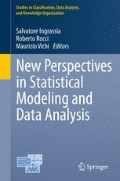Abstract
Synthetic indices are a way of condensing complex situations to give one single value. A very common example of this in environmental studies is that of air quality indices; in their construction, statistics is helpful in summarizing multidimensional information. In this work, we are going to consider synthetic air-quality indices as random quantities, and investigate their main properties by comparing the confidence bands of their cumulative distribution functions.
Access this chapter
Tax calculation will be finalised at checkout
Purchases are for personal use only
Preview
Unable to display preview. Download preview PDF.
References
Beirlant, J., Goegebeur, Y., Segers, J., & Teugels, J. (2004). Statistics of extremes: Theory and applications. Chichester: Wiley.
Bodnar, O., Cameletti, M., Fassó, A., & Schmid, W. (2008). Comparing air quality among Italy, ermany and Poland using BC indexes. Atmospheric Environment, 36, 8412–8421.
Bruno, F., & Cocchi, D. (2002). A unified strategy for building simple air quality indices. Environmetrics, 13, 243–261.
Bruno, F., & Cocchi, D. (2007). Recovering information from synthetic air quality indices. Environmetrics, 18, 345–359.
Coles, S. (2001). An introduction to statistical modeling of extreme values. Springer.
Huerta, G., & Sansó, B. (2007). Time-varying models for extreme values. Environmental and Ecological Statistics, 14, 285–299.
Hurairah, A., Ibrahim, N. A., Daud, I. B., & Haron, K., (2006). Approximate confidence interval for the new extreme value distribution. Engineering Computations, 23, 139–153.
Künsch, H. R. (1989). The jackknife and the bootstrap for general stationary observations. Annals of Statistics, 17, 1217–1241.
Lagona, F., & Maruotti, A. (2009). A hidden Markov model for pollutants exceedances counts. Graspa Working Paper nr. 33,.
Lee, D., Ferguson, C., & Scott, E. M. (2009). Air quality indicators in health studies. In S. Ingrassia & R. Rocci (Eds.), Classification and data analysis (pp. 217–220). Padova: Cleup.
Liu, R. Y., & Singh K. (1992). Moving blocks jackknife and bootstrap capture weak dependence. In R. Lepage & L. Billard (Eds.), Exploring the limits of bootstrap. New York: Wiley.
Lixing, Z. (2005). Nonparametric Monte Carlo tests and their applications. Lecture notes in statistics (Vol. 182). Berlin: Springer-Verlag.
Mignani, S., & Rosa, R. (1995). The moving block bootstrap to assess the accuracy of statistical estimates in Ising model simulations. Computer Physics Communications, 92, 203–213.
Ruggeri, M., Plaia, A., & Bondí, A. L. (2009). Aggregate air pollution indices: A new proposal. In S. Ingrassia & R. Rocci (Eds.), Classification and Data analysis (pp. 221–224). Padova: Cleup.
Sang, H., & Gelfand, A. E. (2009). Hierarchical modeling for extreme values observed over space and time. Environmental and Ecological Statistics, 16, 407–426.
Author information
Authors and Affiliations
Corresponding author
Editor information
Editors and Affiliations
Rights and permissions
Copyright information
© 2011 Springer-Verlag Berlin Heidelberg
About this paper
Cite this paper
Bruno, F., Cocchi, D. (2011). Interpreting Air Quality Indices as Random Quantities. In: Ingrassia, S., Rocci, R., Vichi, M. (eds) New Perspectives in Statistical Modeling and Data Analysis. Studies in Classification, Data Analysis, and Knowledge Organization. Springer, Berlin, Heidelberg. https://doi.org/10.1007/978-3-642-11363-5_49
Download citation
DOI: https://doi.org/10.1007/978-3-642-11363-5_49
Published:
Publisher Name: Springer, Berlin, Heidelberg
Print ISBN: 978-3-642-11362-8
Online ISBN: 978-3-642-11363-5
eBook Packages: Mathematics and StatisticsMathematics and Statistics (R0)

